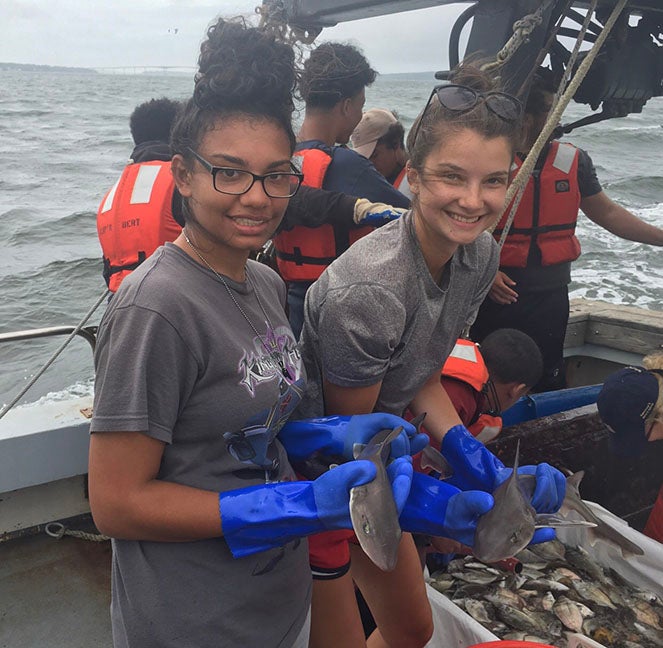KINGSTON, R.I. – October 9, 2018 – When University of Rhode Island sophomores Johniah Gomez and Elizabeth Saraf learned they had an opportunity to spend the summer studying sharks, they had no idea they would spend a whole month building the gear they were going to use to capture sharks, nor that they would spend hours and hours on boats waiting for the animals to bite.
But that’s the nature of wildlife research, and it was a lesson they were happy to learn.
The students worked in collaboration with URI shark biologist Bradley Wetherbee on several projects designed to investigate shark behavior and migration.
They constructed three 1,200-foot fishing lines, each with 20 hooks attached and each connected to two large buoys. To succeed, they had to become experts at splicing ropes together, crimping metal, and creating what they called gangions to which they attached the hooks. Then they spent two or three days a week for a month deploying their fishing lines for three hours at a time in hopes of catching a shark. Which they never did.
“A lot more work goes into fishing and conducting field work than I would have ever thought,” said Saraf, a marine biology major from Buffalo, N.Y. “You have to start from scratch – build the line, find some volunteer helpers, get the boat, bait the hooks – and you still might not catch anything. You need patience, and eventually you’ll be rewarded.”
The reward came during two days in August when they went shark fishing off Block Island using conventional rods and reels and caught several blue sharks and a mako.
“We saw sharks all day on both trips, including a hammerhead that just swam by and ignored us,” said Gomez, a resident of Meriden, Conn., who is majoring in wildlife and conservation biology. “It was a lot of work fighting to reel in an eight-foot blue shark, and it was my first time ever on a boat, so it was really exciting.”
The blue sharks they caught were affixed with metal tags so if they are recaptured the scientists will know about the animal’s movements. But Wetherbee attached a satellite tag to the mako shark so he and the students could monitor its behaviors and migratory patterns every day for up to a year.
“Seeing our first mako made all the work worthwhile,” Saraf said. “It was also great to meet so many other people who love sharks as much as we do.”
After watching a seal show at Sea World as a young child, Saraf was determined to become a marine biologist. “My interest quickly evolved into a fascination with coral reef ecology,” she said. “Seals and dolphins and sharks live in a whole different world than I could see in Buffalo, and that made me want to learn more about them.”
Gomez developed a similar fascination with wildlife at an early age.
“It started out in my backyard looking at insects, and then it grew to larger vertebrates,” she said. “I found it really interesting how many different species are out there. Most classes are so human centered, but I was especially interested in learning about all these other species and how they live and behave.”
In addition to their work to capture and tag sharks, the students used data from previously tagged sharks to study when, where and why sharks come to the surface.
“Sharks are crepuscular, so they surface mostly at dawn and dusk because that’s when their prey is at the surface,” Saraf said. “It has to do with the light. Mako sharks seem to do it most between latitude 45 and 55 degrees. Just past that and they don’t do it at all. We’re still trying to figure out why that is.”
The students also assisted Wetherbee with URI’s first Shark Camp, a week-long summer program offering urban high school students an opportunity to learn about and see sharks in Rhode Island waters. They served as mentors to the camp participants, introduced them to campus life, answered their questions about sharks, and assisted Wetherbee during field trips.
“I’m usually the quiet introvert, so being put in that position was a great learning experience,” Gomez said.
Gomez and Saraf were supported in their summer research with URI-funded fellowships. Gomez was a Science and Engineering Fellow, while Saraf was a Coastal Fellow. Both fellowship programs are designed to involve undergraduate students in addressing real-world issues. The students were paired with a mentor and research staff to help them gain skills relevant to their academic major and future occupations.
With their shark research nearing an end, the students are now looking forward to their next big wildlife adventures. Saraf plans to spend a semester studying coral reefs and reef sharks in Bermuda next fall, while Gomez hopes to learn about tropical conservation in Hawaii next summer.
They are also looking a little farther into the future and making preliminary plans for their careers after graduation. Gomez is certain she wants to work in the field of wildlife conservation, though she’s not sure whether it will be in the terrestrial or marine environment. Saraf is interested in conducting research to combat climate change and spread awareness of the importance of the ocean environment.
“I also hope to work at a marine rehabilitation center,” Saraf concluded. “I visited one in Florida where they were rehabilitating manatees and alligators before they were released back into the wild. Most of their injuries were caused by human impacts, and I hope to help create a world where those occurrences are at a minimum.”

